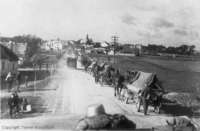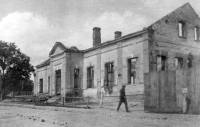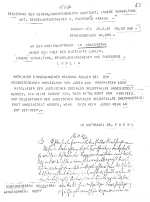 |
 |
 |
 |
 |
 |
 |
| Ghettos |
The most active Jewish community in this region was in Izbica, located only 14 km from Krasnystaw, where the number of Jews was much greater. Shortly before the war about 2,500 Jews lived in Krasnystaw out of a total population of 10,000. Krasnystaw was a typical shtetl and most of the Jews were merchants and artisans. Not far from Krasnystaw, in the village Borowica, Szmuel Zygielbojm, one of the leaders of the Bund (Jewish Socialist Party) in Poland, and during the war a representative of the Polish Government in Exile in London, was born in 1895. In 1943 he committed suicide on the final liquidation of the Warsaw Ghetto. His suicide was an act of protest against the indifference of the world in the face of the annihilation of the Jews of Poland.
 |
| Germans invading Krasnystaw * |
 |
| Germans in Krasnystaw |
On 24 September 1939 the Soviet Army, which had invaded eastern Poland on 17 September, arrived in Krasnystaw and remained there for about two weeks. During the subsequent withdrawal of the Soviet Army, many Jews, especially younger members of the community, decided to leave with them. However, it is difficult to accurately estimate how many Jews then left the town.
The Germans returned to Krasnystaw and new atrocities against the Jews were organised. Poles were also extensively persecuted during this period of the Nazi occupation. At the beginning of 1940, many members of the Polish intelligentsia in Krasnystaw were arrested and deported to concentration camps in Germany. Additionally, a number of Polish intellectuals were executed in Chelm, at Kumowa Dolina (Kumowa Valley).
 |
| Destroyed Synagogue * |
In comparison with other towns in the Lublin district, the ghetto in Krasnystaw was established very quickly in August 1940. The German administration in the town (Krasnystaw was the county town for the whole region) decided to remove the Jews from the town centre, officially claiming that Krasnystaw had been destroyed in September 1939 and that German institutions required more space for themselves.
 |
| Grobla * |
At first the ghetto was not closed, but Jews were not allowed to enter the centre of Krasnystaw. During the move to the ghetto and later, particularly before the German invasion of the Soviet Union in 1941, a group of 300-400 Jews was resettled to Izbica and to the neighbouring village of Siennica Rozana. The official order concerning this resettlement from Krasnystaw stated that the German army required more space for its troops. Before the invasion of the Soviet Union, German soldiers attacked the ghetto several times, assaulting Jews on the street (the ghetto consisted of a single, long street) and plundering their homes.
In 1941 the ghetto was closed, and surrounded by barbed wire. Simultaneously, a work camp for Jews was organised in Krasnystaw, close to the Borek Forest, and Jews working for the Wehrmacht (Heeresmunitionslager / ammunition depot for the armed forces) were initially taken there every day. In 1942 two barracks were built for the prisoners at the labour camp, where they lived until the liquidation of the camp.
The next resettlement of Jews from the Krasnystaw Ghetto was on 12 April 1942, when the first deportations to the death camps had already begun within the framework of Aktion Reinhard. A large group was removed from the ghetto to Izbica and later, together with Jews from that town, deported to the Belzec death camp. As the Kreishauptmann explained, this resettlement from Krasnystaw was necessary because the first transports, containing deported Czech and German Jews, had already arrived in Krasnystaw County and the Germans required space to accommodate them. Most of the foreign Jews were settled in Izbica, Krasniczyn and Gorzkow. Foreign Jews were not settled in the Krasnystaw ghetto; however, a group of about 400 Czech Jews, mainly young and strong men, were selected from the transports and were sent to the work camp near the Borek Forest.
 |
| Re. JSS |
Dov Freiberg, a survivor of Sobibor, who was amongst those deported from Turobin, described this deportation:
"(...) On 12 May, SS-men and Ukrainians surrounded the town. Early in the morning, they announced that we were going to be deported and that by 9 o'clock all Jews should be in the town square. I came there with my aunt. My uncle and their children went into hiding. I was so fed up with the life we had been leading that I decided to go, but it didn't occur to me that we were going to be sent to a death camp. At the square were carts for the children and for the bundles. All the rest were compelled to go on foot. Many people, the elderly and sick and those found in the houses, were shot on the spot. Close to me was a paralysed man in a wheelchair. An SS-man approached him, put his gun to the man's head and pressed the trigger. No shot came. The man's face convulsed, his eyes filled with tears, but the SS-man continued his 'game' and finally shot him. I stood close by, frozen, unable to cry.
After some hours came the order to move. We left the town, mainly families with their old, their babies, and their bundles. On the way we were joined by Jews from Wysokie. We marched silently, guarded by Germans and Ukrainians on horses and bicycles. The weak fell and remained behind. From time to time we heard shots; those who had remained behind were shot. We marched for two days and two nights about 30 km. We passed through villages. People stood and watched us. Some of them laughed, others closed themselves into their houses, but there were also some who gave us water.
When we passed through Zolkiewka and Gorzkow, the local Jews joined our marching column, and our number increased to 4.000. We continued walking. The sky became cruel to us. After the burning sun, which weakened us and caused deaths, came a storm with torrential rain, thunder and lightning. We were soaking wet and the marching column became part of the mud. It was hard to walk.
We arrived at the railway station in Krasnystaw, where we stayed for a few hours. Then the Ukrainians pushed us into the train, about 150 to each car. We were told that we were going to the Ukraine to work. On the other hand, there were people who were told that we were being sent to Majdanek camp. But when we looked through the small window, we realized that we were not going in the direction of Lublin. That meant that our destination was not Majdanek. We were delighted. After a few hours of travelling, we arrived at Sobibor."
Among those deported to Sobibor on 14 May 1942 was Michel Szolsohn, the President of the Jewish Social Selfhelp (Jüdische Soziale Selbsthilfe) for the entire Krasnystaw County. In the first period of Aktion Reinhard, members of the JSS were released from deportation as privileged people. However, in Krasnystaw something different occurred. Szolsohn was in effect deported because of the conflict between himself and members of the Judenrat and the German administration. His deportation to Sobibor was an act of pure revenge. Szolsohn, in opposition to the Judenrat, tried to help poor Jews not only in Krasnystaw but also throughout the entire county. Jews held him in high esteem as an honest and modest person. His children tried to help him and sent a telegram to the Central Office of the JSS in Krakow. In this message, the name of Sobibor was mentioned for the first time as the destination of the transports from Krasnystaw. The children of Szolsohn knew where their father was deported to, but they did not know exactly what transport to Sobibor meant. They hoped that their father could be released from this camp. Of course, it never happened. The Judenräte of Krasnystaw and Izbica explained in a letter to the Krakow JSS that it would be better for everybody to not become involved in this problem. It would be interesting to know the source of Szolsohn's children's knowledge of Sobibor. At that time even the Polish underground were unaware of this death camp.
After the May deportation from Krasnystaw, only a very small number of Jews were left in the ghetto mainly the members of the Judenrat and Jewish policemen, together with their families. This last group cleared the ghetto of Jewish possessions. In October 1942 the ghetto was finally liquidated. Most of the Jews were sent to Izbica, which was then the main transit ghetto for Krasnystaw and Zamosc counties. From there most of them were deported to the Belzec death camp.
A small group of Jews from Krasnystaw were executed at the town's Jewish cemetery or in the Borek Forest, where some Czech Jews who were in the work camp, which was liquidated at that time, were also executed. Selected, healthy men from the ghetto clearing commando were deported to the work camp in Trawniki.
Among those deported to Izbica in October 1942 was Jakub Knobl, his wife Aniela and his sister Estera. Jakub has been befriended by a Pole from Krasnystaw, Jan Osiewicz, who visited him in the Izbica Ghetto and offered help. Jakub refused aid, unwilling to part with his family. Jan then organized false documentation for Aniela and her departure for work in Germany. When Estera approached Jan for assistance, he rented an apartment for her at Krupe and later took her into his home. He also cared for the Honigman family of four people, placing them with a farmer, Karol Olecha, at Wielkopole.
Thus seven persons were saved from certain death. For his bravery and compassion, Jan Osiewicz was recognized by Yad Vashem as a Righteous Among the Nations.
Photos:
Tomek Wisniewski *
Bogdan Lisze Collection *
Sources:
Archive of Jewish Historical Institute in Warsaw: Collection of the documents of Jewish Social Selfhelp from Krasnystaw county and Collection of the testimonies by survivors.
Archive of Majdanek State Museum in Lublin: Collection of the Majdanek camp documents.
Archive of Institute of National Memory in Lublin: Collection of the documents of Regional Commission for the Investigation of Nazi Crimes in Lublin, 1966-1967.
Y. Arad: Belzec, Sobibor, Treblinka. The Operation Reinhard Death Camps. Bloomington and Indianapolis 1999.
www.jewishgen.org
 |
| 2,000 Jews lived in the ghetto |
© ARC 2005